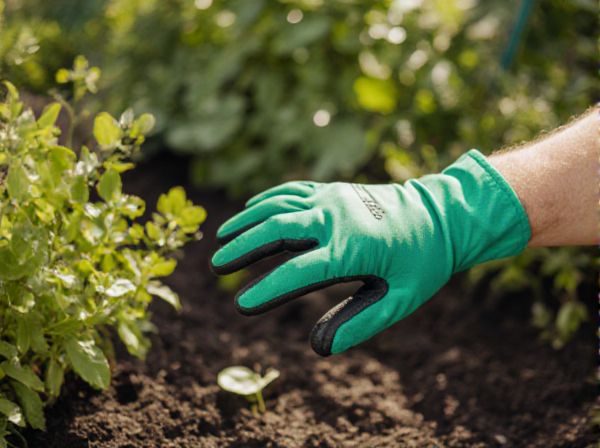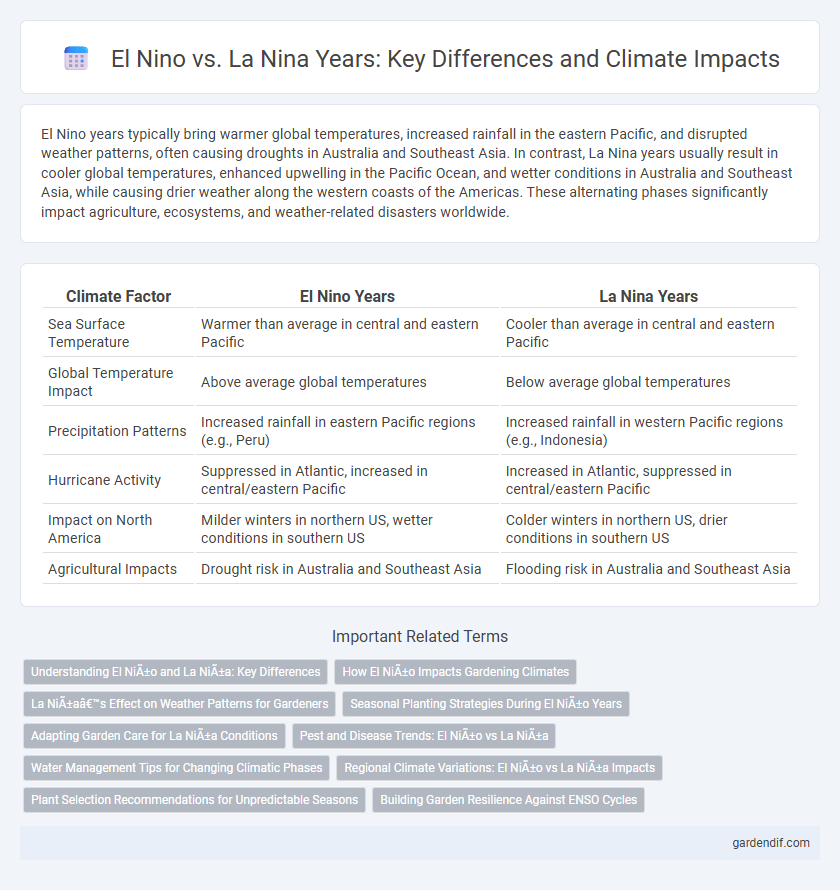
El Niño years vs La Niña years Illustration
El Nino years typically bring warmer global temperatures, increased rainfall in the eastern Pacific, and disrupted weather patterns, often causing droughts in Australia and Southeast Asia. In contrast, La Nina years usually result in cooler global temperatures, enhanced upwelling in the Pacific Ocean, and wetter conditions in Australia and Southeast Asia, while causing drier weather along the western coasts of the Americas. These alternating phases significantly impact agriculture, ecosystems, and weather-related disasters worldwide.
Table of Comparison
| Climate Factor | El Nino Years | La Nina Years |
|---|---|---|
| Sea Surface Temperature | Warmer than average in central and eastern Pacific | Cooler than average in central and eastern Pacific |
| Global Temperature Impact | Above average global temperatures | Below average global temperatures |
| Precipitation Patterns | Increased rainfall in eastern Pacific regions (e.g., Peru) | Increased rainfall in western Pacific regions (e.g., Indonesia) |
| Hurricane Activity | Suppressed in Atlantic, increased in central/eastern Pacific | Increased in Atlantic, suppressed in central/eastern Pacific |
| Impact on North America | Milder winters in northern US, wetter conditions in southern US | Colder winters in northern US, drier conditions in southern US |
| Agricultural Impacts | Drought risk in Australia and Southeast Asia | Flooding risk in Australia and Southeast Asia |
Understanding El Niño and La Niña: Key Differences
El Nino years are characterized by unusually warm ocean temperatures in the central and eastern Pacific, leading to disrupted weather patterns such as increased rainfall in the Americas and droughts in Australia and Indonesia. In contrast, La Nina years feature cooler-than-average sea surface temperatures in the same regions, often causing opposite climatic effects like enhanced hurricane activity in the Atlantic and wetter conditions in Southeast Asia. These oscillations significantly influence global climate variability, affecting temperature, precipitation, and atmospheric circulation on seasonal to interannual timescales.
How El Niño Impacts Gardening Climates
El Nino events typically increase global temperatures and alter precipitation patterns, resulting in warmer and drier conditions in many gardening regions. These changes can stress plants by reducing soil moisture and increasing the risk of drought-related damage, limiting the growing season for sensitive crops. Gardeners must adjust watering schedules and select drought-tolerant species to maintain plant health during El Nino years.
La Niña’s Effect on Weather Patterns for Gardeners
La Nina years typically bring cooler, wetter conditions in the Pacific Northwest, promoting lush garden growth and reducing the need for frequent irrigation. In contrast, southeastern US regions often experience hotter, drier weather during La Nina phases, increasing the stress on plants and necessitating more vigilant watering schedules. Gardeners can optimize plant health by adjusting watering and soil management strategies according to La Nina-induced shifts in temperature and precipitation patterns.
Seasonal Planting Strategies During El Niño Years
El Nino years typically bring warmer ocean temperatures and altered precipitation patterns, impacting regional rainfall and soil moisture crucial for planting schedules. Farmers adjust seasonal planting strategies by selecting drought-resistant crops and timing sowing to avoid anticipated dry spells and erratic rainfall during El Nino events. These adaptive practices enhance crop resilience and optimize yield despite climatic variability associated with El Nino conditions.
Adapting Garden Care for La Niña Conditions
La Nina years bring cooler ocean temperatures and increased rainfall, significantly affecting soil moisture and plant growth cycles. Gardeners should adjust watering schedules to prevent overwatering and choose hardy, water-tolerant plant species to thrive in these wetter, cooler conditions. Proper mulch application is essential to regulate soil temperature and reduce erosion during La Nina's intensified precipitation periods.
Pest and Disease Trends: El Niño vs La Niña
El Nino years often bring warmer ocean temperatures that accelerate pest reproduction and amplify disease outbreaks in crops by disrupting normal rainfall patterns. La Nina tends to cause cooler, wetter conditions that can reduce some pest populations but increase fungal and bacterial plant diseases due to higher humidity. Understanding these distinct climate impacts is crucial for developing adaptive pest and disease management strategies in agriculture.
Water Management Tips for Changing Climatic Phases
El Nino years bring increased rainfall and flooding risks requiring enhanced water storage and flood control strategies, while La Nina years often cause drought conditions necessitating water conservation and efficient irrigation practices. Implementing adaptive water management systems that monitor sea surface temperature anomalies can improve preparedness and resource allocation during these shifting climatic phases. Emphasizing rainwater harvesting during wetter El Nino periods supports resilience, as does enforcing usage restrictions and promoting drought-resistant crops in La Nina intervals.
Regional Climate Variations: El Niño vs La Niña Impacts
El Nino years typically bring warmer Pacific Ocean temperatures, causing increased rainfall in the southern United States and Peru while triggering drought in Australia and Southeast Asia. La Nina years reverse these patterns, often resulting in cooler ocean temperatures, enhanced monsoon activity in South Asia, and wetter conditions in Australia and Indonesia. These opposing phases of the ENSO cycle significantly influence regional climate variability, impacting agriculture, water resources, and disaster preparedness worldwide.
Plant Selection Recommendations for Unpredictable Seasons
El Nino years typically bring warmer ocean temperatures and increased rainfall, favoring heat-tolerant and moisture-loving plant species like tropical fruits and certain legumes. La Nina years often result in cooler, drier conditions, making drought-resistant plants such as succulents, native grasses, and resilient vegetables more suitable. Selecting plant varieties with flexible growth habits and diversified root systems helps gardeners adapt to the unpredictable seasonal shifts caused by these contrasting climate phenomena.
Building Garden Resilience Against ENSO Cycles
El Nino years bring warmer ocean temperatures and altered precipitation patterns that can stress garden plants through heat and drought, while La Nina years often cause cooler, wetter conditions, increasing risks of flooding and fungal diseases. Gardeners can build resilience by selecting drought-tolerant native plants for El Nino periods and improving drainage systems to handle excess moisture during La Nina cycles. Implementing mulch layers and soil amendments helps maintain moisture balance and nutrient availability to support plant health throughout fluctuating ENSO phases.
El Niño years vs La Niña years Infographic

 gardendif.com
gardendif.com